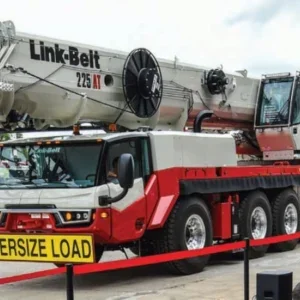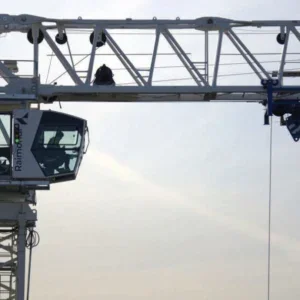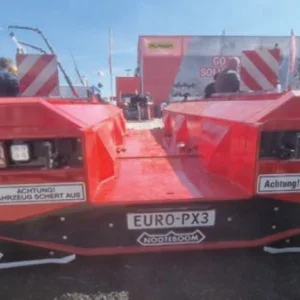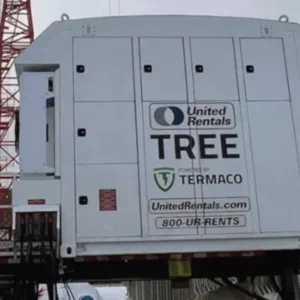High above the crowded construction site, the tower crane operator carefully rotates the boom carrying a load of rebar. Suddenly, a brief back pain breaks his concentration, and the operator realises he’s soaked in sweat. Now it’s hard to breathe, and new and deeper pain fills his chest. Unconscious, he slumps over the console.
Dozens of workers on the ground rush to the base of the crane when it’s clear what has happened. Soon a fire truck arrives, and members of its crew climb the tower. As they apply first aid to stabilise the crane operator, it becomes obvious that getting him down safely will be a very big problem.
The construction workers attempt to help the fire-rescue team, but neither group knows exactly how to handle a high-elevation rescue. After several hours, they manage to jerry-rig a rescue basket and lower the crane operator 100m to the ground. But it’s too late. The heart attack has killed him.
This is an all too common scenario – an injured or ill worker stranded at high elevation. Unfortunately, in much of the world, the practical skills and knowledge needed for a rescue are rare.
An exception to this general rule is Canada’s far western province, British Columbia (BC). Its four million residents live in an area nearly four times the size of the United Kingdom.
Ten years ago, BC devised an effective, systemic approach to providing consistently safe and timely high-elevation rescues. It has been extended to most of the province, assuring a widespread rescue capability that only one fire department here could deliver before 1995.
If this had been available to the crane operator suffering a heart attack, he probably would have survived. His was one of a cluster of serious tower crane incidents that started 15 years ago. Taken together, they amounted to a loud wake-up call for improvements to our high elevation rescue techniques.
A related issue is a legal requirement that individual BC employers – not fire departments – provide necessary high elevation rescue services for workers. But it would be prohibitively expensive to keep highly-trained, fully-equipped rescue teams on standby at construction and other relatively-short-term job sites.
For instance, with nearly 100 tower cranes working today in Vancouver alone, one estimate puts at Can$1,000 (€707) a day the wages required for a four-member rescue team at a site with one tower crane. This doesn’t include other costs like a one-time, Can$30,000 (€21,235) outlay for equipment and other costs.
The legal issue combined with the tower crane incidents of the early 1990s prompted several employer groups to seek on-demand, high-elevation rescue services from fire departments. Willing in principle, they simply didn’t have the financial resources.
Then construction industry representatives approached WorkSafeBC (formerly known as the Workers’ Compensation Board of British Columbia), which is responsible for occupational health and safety across the province. They wanted WorkSafeBC to establish a programme that would enable fire departments to provide the rescue services. Funding would come from employers’ premiums of about one cent for each Can$100 (€71) of payroll.
It took a few years for that to become a reality. But in 1995, WorkSafeBC launched what is now known as the Technical High Angle Rope Rescue Programme, or THARRP. It addresses the safe rescue of victims from high elevations at angles of at least 45 degrees.
This is a broad, four-way partnership overseen by a joint steering committee representing construction industry employers and unions, local fire service organizations and WorkSafeBC. Day-to-day programme administration is handled by the Construction Safety Association of BC.
High elevation rescue is similar to other work already done by firefighters, but it is not generally covered in their basic training. THARRP fills the gap, allowing individual BC fire departments to designate firefighters to complete 160 hours of rigorous specialised training, a fourth of that dealing specifically with tower crane rescues.
Largely taught in the field, the practical curriculum covers state-of-the-art rope rescue techniques (including fall-restraint and fall-arrest methodologies), a review of tower crane functions, and basic teaching techniques.
On successful completion, students return home as master trainers qualified to train high angle rescue teams in their own departments. The train-the-trainer concept is the heart of the province-wide programme.
Besides paying for training, THARRP also subsidises each fire department’s start-up costs and its ongoing maintenance of rope rescue equipment packages. Participating departments receive an annual stipend of Can$12,000 (€8,500). The programme also pays Can$250 (€177) for each departmental familiarisation visit to a job site and for the administration of an agreement with the employer for high-angle rescue services.
WorkSafeBC committed nearly $3 million to THARRP’s first 10 years, and 28 large fire departments currently participate. This number doesn’t indicate the programme’s full reach because several departments may have a “mutual-aid” agreement under which one of them provides high elevation rope rescue for all areas of an entire region. In fact, 80 per cent of the province is covered.
In late 2004, WorkSafeBC approved another Can$2.1 million to fund THARRP for another five years. By the end of this period, we expect a 17% increase in the number of master trainers and new participation by four more fire departments. As well, the steering committee is considering criteria that would give access to the programme to small fire departments, the majority in the province despite the relatively small areas they cover.
THARRP-trained rescue teams made 121 industrial rescues across the province in the 10 years ending 2004. This is the latest period for which statistics have been analysed. Tower cranes accounted for about 16% of those rescues, so the programme serves both crane operators and other workers by:
* Assuring high-angle rescues for other workers at extreme heights in and out of the construction industry. Examples include ironworkers, building exterior painters, roofers, and window washers.
* Deterring untrained personnel like victims’ co-workers from attempting dangerous rescues.
* Applying THARRP techniques to other rope rescue situations involving workers at low elevations, such as maintenance personnel in confined spaces like boilers.
* Enhancing the firefighters’ own security because they are safer with the programme’s rescue techniques. (Rescue teams also use THARRP skills to help the general population, applying rope rescue techniques at high and low elevations. Examples include injured hikers and victims of auto accidents.)
One member of the THARRP steering committee is an experienced firefighter who helped create the programme. No one knows better that its advanced rescue methods and quicker response times can literally mean the difference between life and death for tower crane operators and others working at high elevation.
He talks about “harness hang syndrome”. This happens when a fall-arrest harness stops someone’s fall, leaving him suspended in mid-air until rescued. The victim’s body weight effectively turns the harness into a tourniquet. If the pressure isn’t relieved in a half hour or so the blood pools internally and the victim may die.
The odds of that happening are reduced dramatically by THARRP. Our rash of serious tower crane incidents 15 years ago has led to more effective high elevation rescues of all kinds, using uniform best practices in most of BC. Though provincial or State-wide standards are critical, they are practically unknown in North America.
It is one of many reasons that WorkSafeBC is proud of the programme, and why we hope others find it a useful model to build on.






